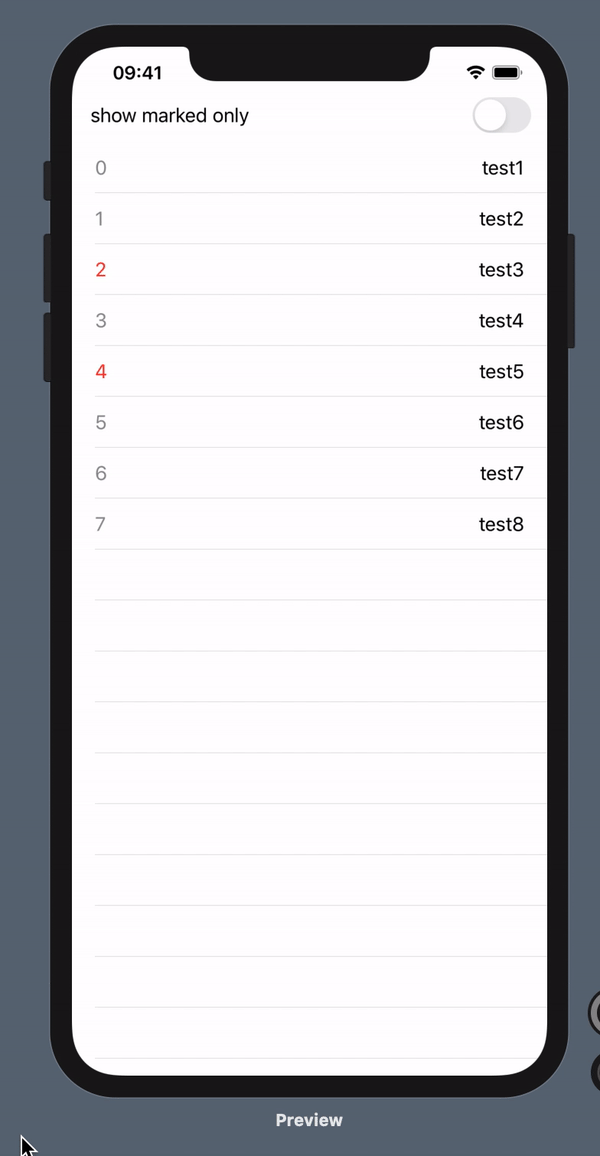出现“致命错误:索引超出范围”:在swiftui
已更新:错误:如果将if闭包(if!self.showMarkedOnly || name.marked {})放在list-foreach中,为什么类型'_'没有成员'1'?
代码版本4:
struct Name: Identifiable, Hashable {
var id: String = UUID().uuidString
var name: String
var marked: Bool
init(_ name: String, marked: Bool = false) { self.name = name; self.marked = marked }
}
struct TestView: View {
@State private var list: [Name] = [Name("test1"), Name("test2"), Name("test3", marked: true), Name("test4"), Name("test5", marked: true), Name("test6"), Name("test7"), Name("test8")]
@State private var showMarkedOnly = false
var body: some View {
VStack{
Toggle(isOn: $showMarkedOnly) { Text("show marked only") }
List {
ForEach(Array(zip(0..., list)), id: \.1.id) { index, name in
// if !self.showMarkedOnly || name.marked {
HStack {
Text("\(index)").foregroundColor(name.marked ? .red : .gray)
Spacer()
Text("\(name.name)")
}
.background(Color.gray.opacity(0.001))
.onTapGesture {
self.list.remove(at: index)
}
// }
}
}
}
}
}
=========
已更新:我发现了代码版本2的问题,我必须提供ForEach的ID。并更新了代码版本2。
我发现了一种显示索引的优美方法,它避免了self.list [index]。但是我发现某些复杂代码中出现了“类型'_'没有成员'1'”错误。
代码版本3:
var body: some View {
List {
ForEach(Array(zip(0..., list)), id: \.1.id) { index, name in // a error occurs in some complex code: "Type '_' has no member '1'"
HStack {
Text("\(index)")
Spacer()
Text("\(name.name)")
}
.background(Color.gray.opacity(0.001))
.onTapGesture {
self.list.remove(at: index)
}
}
}
}
我显示一个列表,并删除我点击的项目。它是代码版本1,工作正常。 当我使用索引(代码版本2)将索引添加到列表项中时,点击后出现“致命错误:索引超出范围”。
代码版本1:
struct Name: Identifiable, Hashable {
var id: String = UUID().uuidString
var name: String
init(_ name: String) { self.name = name }
}
struct TestView: View {
@State private var list: [Name] = [Name("test1"), Name("test2"), Name("test3"), Name("test4"), Name("test5"), Name("test6"), Name("test7"), Name("test8")]
var body: some View {
List {
ForEach(list) { name in
HStack {
Text("\(0)")
Spacer()
Text("\(name.name)")
}
.background(Color.gray.opacity(0.001))
.onTapGesture {
self.list = self.list.filter { $0 != name }
}
}
}
}
}
代码版本2:
struct TestView: View {
@State private var list: [Name] = [Name("test1"), Name("test2"), Name("test3"), Name("test4"), Name("test5"), Name("test6"), Name("test7"), Name("test8")]
var body: some View {
List {
//ForEach(list.indices) { index in
ForEach(list.indices, id: \.self) { index in
HStack {
Text("\(index)")
Spacer()
Text("\(self.list[index].name)")
}
.background(Color.gray.opacity(0.001))
.onTapGesture {
self.list.remove(at: index)
}
}
}
}
}
3 个答案:
答案 0 :(得分:3)
@State是属性包装器,它将强制定义其中的View重新计算其主体。
对于您而言,如果您删除索引处的项目
HStack {
Text("\(index)")
Spacer()
Text("\(self.list[index].name)")
}
.background(Color.gray.opacity(0.001))
.onTapGesture {
self.list.remove(at: index)
}
HStack中的文本
Text("\(self.list[index].name)")
崩溃,只是因为list [index]不再存在。
使用
ForEach(list.indices, id:\.self) { index in ... }
代替
ForEach(list.indices) { index in ... }
将强制SwiftUI重新创建TestView(请参阅ForEach构造函数中的id:\。self)
SwiftUI将使用@State属性包装器中包装的属性的新值来制作TestView的新副本。
更新
请不要更新您的问题...
您的最后一个代码版本4完全混乱,因此我将其重写为可以复制,粘贴和运行的内容
import SwiftUI
struct Name: Identifiable, Hashable {
var id: String = UUID().uuidString
var name: String
var marked: Bool
init(_ name: String, marked: Bool = false) { self.name = name; self.marked = marked }
}
struct ContentView: View {
@State private var list: [Name] = [Name("test1"), Name("test2"), Name("test3", marked: true), Name("test4"), Name("test5", marked: true), Name("test6"), Name("test7"), Name("test8")]
@State private var showMarkedOnly = false
var body: some View {
VStack{
Toggle(isOn: $showMarkedOnly) {
Text("show marked only")
}.padding(.horizontal)
List {
ForEach(Array(zip(0..., list)).filter({!self.showMarkedOnly || $0.1.marked}), id: \.1.id) { index, name in
HStack {
Text("\(index)").foregroundColor(name.marked ? .red : .gray)
Spacer()
Text("\(name.name)")
}
.background(Color.gray.opacity(0.001))
.onTapGesture {
self.list.remove(at: index)
}
}
}
}
}
}
struct ContentView_Previews: PreviewProvider {
static var previews: some View {
ContentView()
}
}
基于讨论的更新
每个版本的构造函数使用内部不同的ViewBuilder功能
@available(iOS 13.0, OSX 10.15, tvOS 13.0, watchOS 6.0, *)
extension ViewBuilder {
/// Provides support for "if" statements in multi-statement closures, producing an `Optional` view
/// that is visible only when the `if` condition evaluates `true`.
public static func buildIf<Content>(_ content: Content?) -> Content? where Content : View
/// Provides support for "if" statements in multi-statement closures, producing
/// ConditionalContent for the "then" branch.
public static func buildEither<TrueContent, FalseContent>(first: TrueContent) -> _ConditionalContent<TrueContent, FalseContent> where TrueContent : View, FalseContent : View
/// Provides support for "if-else" statements in multi-statement closures, producing
/// ConditionalContent for the "else" branch.
public static func buildEither<TrueContent, FalseContent>(second: FalseContent) -> _ConditionalContent<TrueContent, FalseContent> where TrueContent : View, FalseContent : View
}
这是关于“实现细节”的,希望它将在下一版本中进行记录。 SwiftUI仍处于开发的早期阶段,我们必须小心。
让我们尝试迫使SwiftUI遵循我们自己的方式! 第一个单独的RowView
struct RowView: View {
var showMarkedOnly: Bool
var index: Int
var name: Name
//@ViewBuilder
var body: some View {
if !self.showMarkedOnly || name.marked {
HStack {
Text(verbatim: index.description).foregroundColor(name.marked ? .red : .gray)
Spacer()
Text(verbatim: name.name)
}
.background(Color.gray.opacity(0.001))
}
}
}
编译器抱怨
Function declares an opaque return type, but has no return statements in its body from which to infer an underlying type
取消注释以包裹身体的线
struct RowView: View {
var showMarkedOnly: Bool
var index: Int
var name: Name
@ViewBuilder
var body: some View {
if !self.showMarkedOnly || name.marked {
HStack {
Text(verbatim: index.description).foregroundColor(name.marked ? .red : .gray)
Spacer()
Text(verbatim: name.name)
}
.background(Color.gray.opacity(0.001))
}
}
}
现在我们可以按照您喜欢的方式使用代码了:-)
struct ContentView: View {
@State private var list: [Name] = [Name("test1"), Name("test2"), Name("test3", marked: true), Name("test4"), Name("test5", marked: true), Name("test6"), Name("test7"), Name("test8")]
@State private var showMarkedOnly = false
var body: some View {
VStack{
Toggle(isOn: $showMarkedOnly) {
Text("show marked only")
}.padding(.horizontal)
List {
ForEach(Array(zip(0..., list)), id: \.1.id) { (index, name) in
RowView(showMarkedOnly: self.showMarkedOnly, index: index, name: name).onTapGesture {
self.list.remove(at: index)
}
}
}
}
}
}
最终结果现在使用buildIf<Content>构造,并且所有代码都可以再次使用(结果看起来与上面显示的完全一样)
答案 1 :(得分:1)
这是因为indices不是您的状态,而是数组。因此,您更新了数组,但是@State实际上不够聪明,无法更新它包装的值的计算或下游属性。如果需要索引,请在ForEach中将标识符的来源设为
ForEach(0..<list.count, id: \.self) {
// the rest should be ok here
}
答案 2 :(得分:0)
这是因为SwiftUI根据提供的原始数据重新加载其内容。 您可以通过修改
来解决ForEach(list) { item in
HStack {
Text("\(item.id)")
Spacer()
Text("\(item.name)")
}
.onTapGesture {
guard let itemIndex = self.list.firstIndex(of: item) else { return }
self.list.remove(at:itemIndex)
}
}
否则,您可以使用内置的.onDelete()方法(通过滑动项目来删除项目)来解决您的问题:
var body: some View {
List {
ForEach(list) { item in
HStack {
Text("\(item.id)")
Spacer()
Text("\(item.name)")
}
.background(Color.gray.opacity(0.001))
}.onDelete(perform: delete)
}
}
func delete(at offsets: IndexSet) {
list.remove(atOffsets: offsets)
}
- 我写了这段代码,但我无法理解我的错误
- 我无法从一个代码实例的列表中删除 None 值,但我可以在另一个实例中。为什么它适用于一个细分市场而不适用于另一个细分市场?
- 是否有可能使 loadstring 不可能等于打印?卢阿
- java中的random.expovariate()
- Appscript 通过会议在 Google 日历中发送电子邮件和创建活动
- 为什么我的 Onclick 箭头功能在 React 中不起作用?
- 在此代码中是否有使用“this”的替代方法?
- 在 SQL Server 和 PostgreSQL 上查询,我如何从第一个表获得第二个表的可视化
- 每千个数字得到
- 更新了城市边界 KML 文件的来源?
